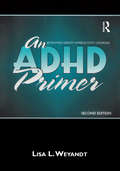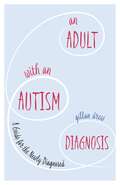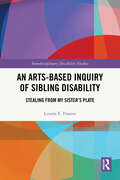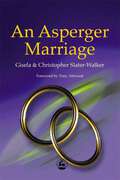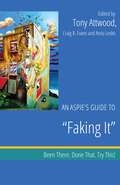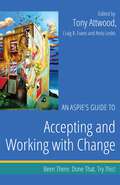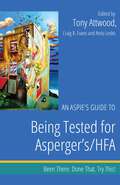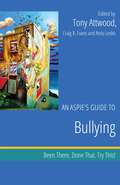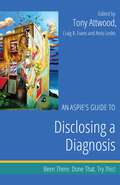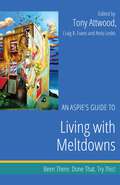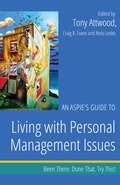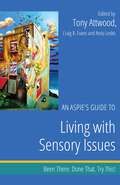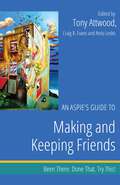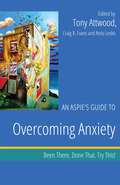- Table View
- List View
Amy Signs: A Mother, Her Deaf Daughter, and Their Stories
by Amy Willman Rebecca Willman Gernon“Thirty-seven years ago, I vowed to write a truthful book about raising a deaf child.” Rebecca Willman Gernon followed through on her promise with her deaf daughter Amy Willman in this extraordinary new narrative. Many stories have been told about a parent’s struggle to help her deaf child succeed in a mostly hearing world. Amy Signs marks a signature departure in that both Rebecca and Amy relate their perspectives on their journey together. When she learns of 11-month-old Amy’s deafness in 1969, Rebecca fully expresses her anguish, and traces all of the difficulties she endured in trying to find the right educational environment for Amy. The sacrifices of the rest of her family weighed heavily on her, also. Though she resolved to place four-year-old Amy in Nebraska’s residential school for deaf students, the emotional toll seemed too much to bear. Amy’s view acts as the perfect counterpoint. Interwoven with her mother’s story, Amy’s account confirms that signing served her best. She summarizes life in boarding school as “laughter and homesickness.” She laughed with all of her deaf friends, though felt homesick at times. Amy thanks her mother for the gift of sign, asserting that a mainstream education would never have led her to earn a master’s degree and later teach American Sign Language at the University of Nebraska. Amy Signs is a positive albeit cautionary tale for parents of deaf children today whose only choice is a mainstreamed education.
An A to Z Practical Guide to Emotional and Behavioural Difficulties
by Harry Ayers Cesia PrytysThe aim of this practical and user-friendly A to Z handbook is to enable the interested reader to gain quick and easy access to entries relating to or associated with emotional and behavioral difficulties. It focuses on adult problems as well as those of children and adolescents. The entries clearly and succinctly define and explain emotional behavioral terms and some of the different ways in which emotional and behavioral problems can be approached or treated. Where appropriate, entries are accompanied by a brief bibliography. Useful addresses and contact phone numbers are also provided where appropriate. This guide is useful for all teachers, mentors, social workers, educational social workers, educational psychologists, counselors, care workers, students and other professionals and voluntary workers in allied fields. It will also be of interest to parents and carers.
An A to Z Practical Guide to Learning Difficulties
by Harry Ayers Francesca GrayAccessing up-to-date information about general and specific learning difficulties is made easy, with this indispensable reference book. Covering difficulties that relate to children, adolescents and adults, it includes: crucial legislation to keep practitioners 'in the know' useful addresses, telephone numbers and websites It also includes explanations of leaning difficulties including those less than well-known syndromes such as semantic pragmatic difficulties.
An ADHD Primer
by Lisa L. WeyandtFilled with current, practical, and useful information for professionals and individuals, this second edition of An ADHD Primer summarizes the literature concerning ADHD across the lifespan. It offers a better understanding of the disorder by addressing the potential causes of ADHD, the developmental course, and numerous treatment approaches. Author Lisa L. Weyandt delivers research-based, cutting-edge knowledge in a concise and user-friendly fashion. The book skillfully explains the scientific literature, often complex, concerning this disorder. Commonly asked questions are addressed, including: What causes ADHD? What does ADHD look like, and how can it be accurately assessed? How can ADHD be treated with and without medication? Weyandt thoroughly tackles these question and more. The text contains helpful tables and appendices, as well as numerous up-to-date resources for readers who desire additional information about the disorder. An ADHD Primer is intended for students enrolled in teacher-certification programs, graduate students enrolled in research and applied training programs, educators, counselors, nurses, psychologists, parents, and individuals with ADHD.
An Adult with an Autism Diagnosis: A Guide for the Newly Diagnosed
by Gillan DrewBeing diagnosed with autism as an adult can be disorienting and isolating; however, if you can understand the condition and how it affects perceptions, relationships, and your relationship with the world in general, a happy and successful life is attainable. Through an introduction to the autism spectrum, and how the Level 1 diagnosis is characterised, the author draws on personal experiences to provide positive advice on dealing with life, health, and relationships following an adult diagnosis. The effect of autism on social skills is described with tips for dealing with family and personal relationships, parenting, living arrangements, and employment. Important topics include disclosure, available resources, and options for different therapeutic routes. On reading this book, you will learn a lot more about the autism spectrum at Level 1, be able to separate the facts from the myths, and gain an appreciation of the strengths of autism, and how autism can affect many aspects of everyday life. Drawing from the author's lived experience, this book is an essential guide for all newly diagnosed adults on the autism spectrum, their families and friends, and all professionals new to working with adults with ASDs.
An Adult with an Autism Diagnosis: A Guide for the Newly Diagnosed
by Gillan DrewBeing diagnosed with autism as an adult can be disorienting and isolating; however, if you can understand the condition and how it affects perceptions, relationships, and your relationship with the world in general, a happy and successful life is attainable. Through an introduction to the autism spectrum, and how the Level 1 diagnosis is characterised, the author draws on personal experiences to provide positive advice on dealing with life, health, and relationships following an adult diagnosis. The effect of autism on social skills is described with tips for dealing with family and personal relationships, parenting, living arrangements, and employment. Important topics include disclosure, available resources, and options for different therapeutic routes. On reading this book, you will learn a lot more about the autism spectrum at Level 1, be able to separate the facts from the myths, and gain an appreciation of the strengths of autism, and how autism can affect many aspects of everyday life. Drawing from the author's lived experience, this book is an essential guide for all newly diagnosed adults on the autism spectrum, their families and friends, and all professionals new to working with adults with ASDs.
An Archaeology of Yearning
by Bruce MillsDigging into vivid moments within the metaphor of archaeology, Bruce Mill's remarkable memoir maps the artifacts of life as a father of a boy with autism, and as a boy himself growing up in rural Iowa. An Archaeology of Yearning is not ultimately about autism; instead it reaches into the world of human connection and illuminates how storytelling and an understanding of language keep that connection alive.On some nights, I awake as if in a cave and think of the future. Mary and I will exist as memories: a quick glimpse of arms reaching toward another's shoulders or face, an image of a hand upon a book, the scent of our bodies after the sweat of sleep, the tone of our young and old voices calling our daughter or son from distant rooms or down a stair.Eventually I arrive on the image of my son, in some new home. No matter how much I have written or catalogued or kept in images, I know that the site of his life and mine will inevitably remain fragments and that only a visitor can bring us to life.Bruce Mills has published scholarly books and articles on nineteenth-century American writings and co-edited a collection of essays by siblings of those on the autism spectrum. His creative nonfiction has appeared in The Georgia Review and New England Review. He teaches in the English Department at Kalamazoo College.
An Arts-Based Inquiry of Sibling Disability: Stealing from My Sister’s Plate (Interdisciplinary Disability Studies)
by Linnéa E. FranitsThis book examines texts and other artistic products rendered by siblings of individuals with disabilities in order to interrogate the impact of disability on the identity of non-disabled siblings. This includes an arts-based analysis of the author’s own experiences as the sister of a woman with disabilities as depicted in photo essays and autoethnographic texts. By providing an alternate presentation of the topics surrounding sibling disability it gives readers a deeper and broader perspective of the lived experience of sibling disability by introducing them to some of the knowledge that is specifically, and perhaps singularly available to siblings of people with disabilities. Presenting findings from narrative analysis, visual analysis, autoethnographic and arts-based research related to sibling disability, it challenges the grand narratives that persist in many cultural products and medical discourses around sibling disability.It will be of interest to all scholars and students of disability studies, sociology, childhood studies, family studies and the arts more broadly.
An Asperger Marriage
by Tony Attwood Gisela Slater-Walker Christopher Slater-WalkerChris and Gisela have been partners for twelve years. Four years ago Chris was diagnosed with Asperger syndrome. For Chris, this was an explanation of why he had always regarded himself as 'socially handicapped'. For Gisela, it meant coming to terms with a marriage in which there would never be an intuitive understanding despite Chris's good intentions. For the couple it was the beginning of a long and still unfinished process of learning to live with a disability regarded by some as incompatible with marriage.
An Aspie’s Guide to "Faking It": Been There. Done That. Try This!
by Tony Attwood Anita Lesko Craig EvansIn order to survive in a Neurotypical world many Aspies feel that they need "fake it" and intentionally wear a mask and play a role so that people will not see who they really are. This can be exhausting and "faking it" is a key daily stressor for people with Asperger's Syndrome. This ebook is packed with advice from Aspie mentors who have all been there, done that, and offer suggestions for coping strategies that really work. Liane Holliday Willey, Jennifer Cook O'Toole, Karen Krejcha and more offer guidance based on their personal experiences of "faking it" and the ebook ends with professional analysis and recommendations from world expert Dr. Tony Attwood. This inspirational advice comes from the bestselling book Been There. Done That. Try This!, written by Aspies for Aspies, now available in short Aspie Mentor Guides!
An Aspie’s Guide to Accepting and Working with Change: Been There. Done That. Try This!
by Tony Attwood Anita Lesko Craig EvansChange is a key daily stressor for people with Asperger's Syndrome and this ebook is packed with advice from Aspie mentors who have all been there, done that, and offer suggestions for coping strategies that really work. Temple Grandin, Lars Perner, Liane Holliday Willey, and more offer guidance based on their personal experiences of accepting and working with change and the ebook ends with professional analysis and recommendations from world expert Dr. Tony Attwood. This inspirational advice comes from the bestselling book Been There. Done That. Try This!, written by Aspies for Aspies, now available in short Aspie Mentor Guides!
An Aspie’s Guide to Being Tested for Asperger's/HFA: Been There. Done That. Try This!
by Tony Attwood Anita Lesko Craig EvansWhether or not to seek an official diagnosis is a key daily stressor for people with Asperger's Syndrome and this ebook is packed with advice from Aspie mentors who have all been there, done that, and offer suggestions on the pros and cons of being tested for Asperger's/HFA. Anita Lesko, Henny Kupferstein, Jeanette Purkis, and more offer guidance based on their personal experiences of seeking formal diagnosis and the ebook ends with professional analysis and recommendations from world expert Dr. Tony Attwood. This inspirational advice comes from the bestselling book Been There. Done That. Try This!, written by Aspies for Aspies, now available in short Aspie Mentor Guides!
An Aspie’s Guide to Bullying: Been There. Done That. Try This!
by Tony Attwood Anita Lesko Craig EvansBullying is a key daily stressor for people with Asperger's Syndrome and this ebook is packed with advice from Aspie mentors who have all been there, done that, and offer suggestions for coping strategies that really work. Alexis Wineman, Anita Lesko, Karen Krejcha, and more offer guidance based on their personal experiences of overcoming bullying and the ebook ends with professional analysis and recommendations from world expert Dr. Tony Attwood. This inspirational advice comes from the bestselling book Been There. Done That. Try This!, written by Aspies for Aspies, now available in short Aspie Mentor Guides!
An Aspie’s Guide to Choosing a Career: Been There. Done That. Try This!
by Tony Attwood Anita Lesko Craig EvansChoosing the right career is a key daily stressor for people with Asperger's Syndrome and this ebook is packed with advice from Aspie mentors who have all been there, done that, and offer career guidance that really work. Lars Perner, Anita Lesko, Debbie Denenburg, and more offer guidance based on their personal experiences of choosing a career and the ebook ends with professional analysis and recommendations from world expert Dr. Tony Attwood. This inspirational advice comes from the bestselling book Been There. Done That. Try This!, written by Aspies for Aspies, now available in short Aspie Mentor Guides!
An Aspie’s Guide to Disclosing a Diagnosis: Been There. Done That. Try This!
by Tony Attwood Anita Lesko Craig EvansDisclosing a diagnosis is a key daily stressor for people with Asperger's Syndrome and this ebook is packed with advice from Aspie mentors who have all been there, done that, and offer suggestions for disclosure strategies that really work. Qazi Fazli Azeem, Mary Robison, Anita Lesko and more offer guidance based on their personal experiences of disclosing to friends, family and employers and the ebook ends with professional analysis and recommendations from world expert Dr. Tony Attwood. This inspirational advice comes from the bestselling book Been There. Done That. Try This!, written by Aspies for Aspies, now available in short Aspie Mentor Guides!
An Aspie’s Guide to Getting and Keeping a Job: Been There. Done That. Try This!
by Tony Attwood Anita Lesko Craig EvansGetting and keeping a job is a key daily stressor for people with Asperger's Syndrome and this ebook is packed with advice from Aspie mentors who have all been there, done that, and offer suggestions for employment strategies that really work. Temple Grandin, Richard Maguire, Anita Lesko and more offer guidance based on their personal jobhunting and employment experiences and the ebook ends with professional analysis and recommendations from world expert Dr. Tony Attwood. This inspirational advice comes from the bestselling book Been There. Done That. Try This!, written by Aspies for Aspies, now available in short Aspie Mentor Guides!
An Aspie’s Guide to Improving Empathetic Attunement: Been There. Done That. Try This!
by Tony Attwood Anita Lesko Craig EvansDifficulties with feeling empathy or being perceiving to have a lack of empathy is a key daily stressor for people with Asperger's Syndrome and this ebook is packed with advice from Aspie mentors who have all been there, done that, and offer strategies that really work to improve empathetic attunement. Dr. Patrick Suglia, Paul Isaacs, Anita Lesko, and more offer guidance based on their personal experiences and the ebook ends with professional analysis and recommendations from world expert Dr. Tony Attwood. This inspirational advice comes from the bestselling book Been There. Done That. Try This!, written by Aspies for Aspies, now available in short Aspie Mentor Guides!
An Aspie’s Guide to Intimacy, Dating, Sex and Marriage: Been There. Done That. Try This!
by Tony Attwood Anita Lesko Craig EvansIntimacy, dating, sex and marriage are key daily stressors for people with Asperger's Syndrome and this ebook is packed with advice from Aspie mentors who have all been there, done that, and offer suggestions for relationship strategies that really work. Jennifer Cook O'Toole, Jeanette Purkis, Richard Maguire and more offer guidance based on their personal dating and relationship experiences and the ebook ends with professional analysis and recommendations from world expert Dr. Tony Attwood. This inspirational advice comes from the bestselling book Been There. Done That. Try This!, written by Aspies for Aspies, now available in short Aspie Mentor Guides!
An Aspie’s Guide to Living with Meltdowns: Been There. Done That. Try This!
by Tony Attwood Anita Lesko Craig EvansMeltdowns are a key daily stressor for people with Asperger's Syndrome and this ebook is packed with advice from Aspie mentors who have all been there, done that, and offer suggestions for coping strategies that really work. Mitch Christian, Anita Lesko, Dr. Patrick Suglia, and more offer guidance based on their personal experiences of managing meltdowns and the ebook ends with professional analysis and recommendations from world expert Dr. Tony Attwood. This inspirational advice comes from the bestselling book Been There. Done That. Try This!, written by Aspies for Aspies, now available in short Aspie Mentor Guides!
An Aspie’s Guide to Living with Personal Management Issues: Been There. Done That. Try This!
by Tony Attwood Anita Lesko Craig EvansPersonal management issues such as organization and decision-making are a key daily stressor for people with Asperger's Syndrome and this ebook is packed with advice from Aspie mentors who have all been there, done that, and offer suggestions for coping strategies that really work. Mary Robison, Anita Lesko, Lars Perner and more offer guidance based on their personal experiences of coping with personal management issues and the ebook ends with professional analysis and recommendations from world expert Dr. Tony Attwood. This inspirational advice comes from the bestselling book Been There. Done That. Try This!, written by Aspies for Aspies, now available in short Aspie Mentor Guides!
An Aspie’s Guide to Living with Sensory Issues: Been There. Done That. Try This!
by Tony Attwood Anita Lesko Craig EvansSensory issues are a key daily stressor for people with Asperger's Syndrome and this ebook is packed with advice from Aspie mentors who have all been there, done that, and offer suggestions for coping strategies that really work. Paul Isaacs, Lars Perner, Dr. Stephen M. Shore, and more offer guidance based on their personal experiences of living with sensory issues and the ebook ends with professional analysis and recommendations from world expert Dr. Tony Attwood. This inspirational advice comes from the bestselling book Been There. Done That. Try This!, written by Aspies for Aspies, now available in short Aspie Mentor Guides!
An Aspie’s Guide to Making and Keeping Friends: Been There. Done That. Try This!
by Tony Attwood Anita Lesko Craig EvansFriendship problems are a key daily stressor for people with Asperger's Syndrome and this ebook is packed with advice from Aspie mentors who have all been there, done that, and offer suggestions for social strategies that really work. Anita Lesko, Lisa Morgan, Jennifer Cook O'Toole, and more offer guidance based on their personal experiences of making and keeping friends and the ebook ends with professional analysis and recommendations from world expert Dr. Tony Attwood. This inspirational advice comes from the bestselling book Been There. Done That. Try This!, written by Aspies for Aspies, now available in short Aspie Mentor Guides!
An Aspie’s Guide to Overcoming Anxiety: Been There. Done That. Try This!
by Tony Attwood Anita Lesko Craig EvansAnxiety is a key daily stressor for people with Asperger's Syndrome and this ebook is packed with advice from Aspie mentors who have all been there, done that, and offer suggestions for coping strategies that really work. Liane Holliday Willey, Anita Lesko, Jennifer Cook O'Toole, and more offer guidance based on their personal experiences of dealing with anxiety and the ebook ends with professional analysis and recommendations from world expert Dr. Tony Attwood. This inspirational advice comes from the bestselling book Been There. Done That. Try This!, written by Aspies for Aspies, now available in short Aspie Mentor Guides!
An Aspie’s Guide to Overcoming Depression: Been There. Done That. Try This!
by Tony Attwood Anita Lesko Craig EvansDepression is a key daily stressor for people with Asperger's Syndrome and this ebook is packed with advice from Aspie mentors who have all been there, done that, and offer suggestions for coping strategies that really work. Temple Grandin, Qazi Fazli Azeem, Ruth Elaine Joyner Hane, and more offer guidance based on their personal experiences of overcoming depression and the ebook ends with professional analysis and recommendations from world expert Dr. Tony Attwood. This inspirational advice comes from the bestselling book Been There. Done That. Try This!, written by Aspies for Aspies, now available in short Aspie Mentor Guides!
An Aspie’s Guide to Overcoming Poor Self-Esteem: Been There. Done That. Try This!
by Tony Attwood Anita Lesko Craig EvansLow self-esteem is a key daily stressor for people with Asperger's Syndrome and this ebook is packed with advice from Aspie mentors who have all been there, done that, and offer suggestions for coping strategies that really work. Alexis Wineman, Liane Holliday Willey, Anita Lesko, and more offer guidance based on their personal experiences of boosting their self-esteem and self-confidence and the ebook ends with professional analysis and recommendations from world expert Dr. Tony Attwood. This inspirational advice comes from the bestselling book Been There. Done That. Try This!, written by Aspies for Aspies, now available in short Aspie Mentor Guides!



